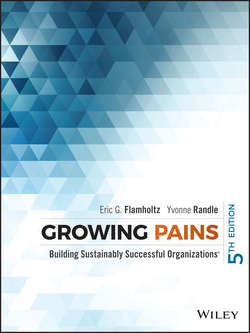Читать книгу Growing Pains - Flamholtz Eric G. - Страница 3
Preface
ОглавлениеGrowing Pains deals with the problems of building sustainably successful organizations® over the long term. The first edition of this book – published in 1986 and titled, How to Make the Transition from Entrepreneurship to a Professionally Managed Firm– was written after Eric Flamholtz became aware of the paucity of theory, research, and tools for the management of entrepreneurial organizations.
Prior to the first edition of this book, most if not virtually all of business education ignored entrepreneurship and focused instead on “business administration.” This meant focusing on large established companies such as Bank of America, Boeing, Exxon, IBM, McDonald's, Procter & Gamble, and similar institutional “blue chip” companies that had already been in existence for many decades. There was very little literature or cases about starting entrepreneurial firms, or about what we like to think of as “organizational scale-up,” the process of transitioning from a successful start-up to a much larger size and different stage of growth.
Now, three decades later, entrepreneurship is an established academic field. Entrepreneurs like Howard Schultz (Starbucks), Richard Branson (the Virgin Group), and the late Steve Jobs (Apple), and more recently Elon Musk (Tesla), Jack Ma (Alibaba), and Mark Zuckerberg (Facebook) are business icons and business heroes. However, there still remains a large gap in the published literature to explain the process of transitioning from the start-up phase of early entrepreneurship to the end-game phase of becoming a sustainably successful organization (or institution) like Starbucks, Apple, or Amgen. Filling this gap is and has been (for almost 40 years) our primary academic and practical focus.
During this period, we have developed one model to explain the determinants of organizational success, another to identify the stages in an organizational life cycle, and a third to explain the origin and underlying causes of growing pains (which occur when an organization has not developed the infrastructure required by its size and complexity at a given stage of growth). Initially, these models were developed to help explain the process of transition from the entrepreneurial stage to the professional management stage (see Chapter 3) in the life cycle of a business enterprise. Later we realized that what we had actually developed was an explanation or general theory of organizational success and failure at different stages of growth.
